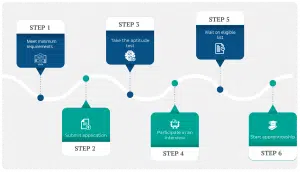The Air Force Officer Qualifying Test, or AFOQT, is a standardized test used by the United States Air Force to measure the aptitudes of candidates for officer commission programs and specific officer training programs. If you are interested in attending Officer Training School, Air Force ROTC, or being selected into programs like pilot and navigator training, you must perform well on this exam.
The test covers 12 different subsets of information, has 516 questions, and takes approximately 5 hours to complete. Your score results from the different sections will be used to measure your aptitude for Air Force officer commissions. You should try to find AFOQT practice tests that tackle the most important test sections.
Did you know?
The AFOQT is a timed 516-question test and is used to determine a candidate’s aptitude for officer training. A good AFOQT practice test covers the five sections that you need to pass to commission.These are (1) verbal analogies, (2) arithmetic reasoning, (3) word knowledge, (4) math knowledge, and (5) reading comprehension. The remaining sections are used to assess aptitude.
AFOQT Question Types
There are 12 sections on the AFOQT. Some measure basic skills, and you must pass those questions to be considered for any type of commission. They are verbal analogies, arithmetic reasoning, word knowledge, math knowledge, and reading comprehension. The additional seven sections, which are situational judgment, self-description inventory, physical science, table reading, instrument comprehension, block counting, and aviation information, are used to determine your capabilities and skills.
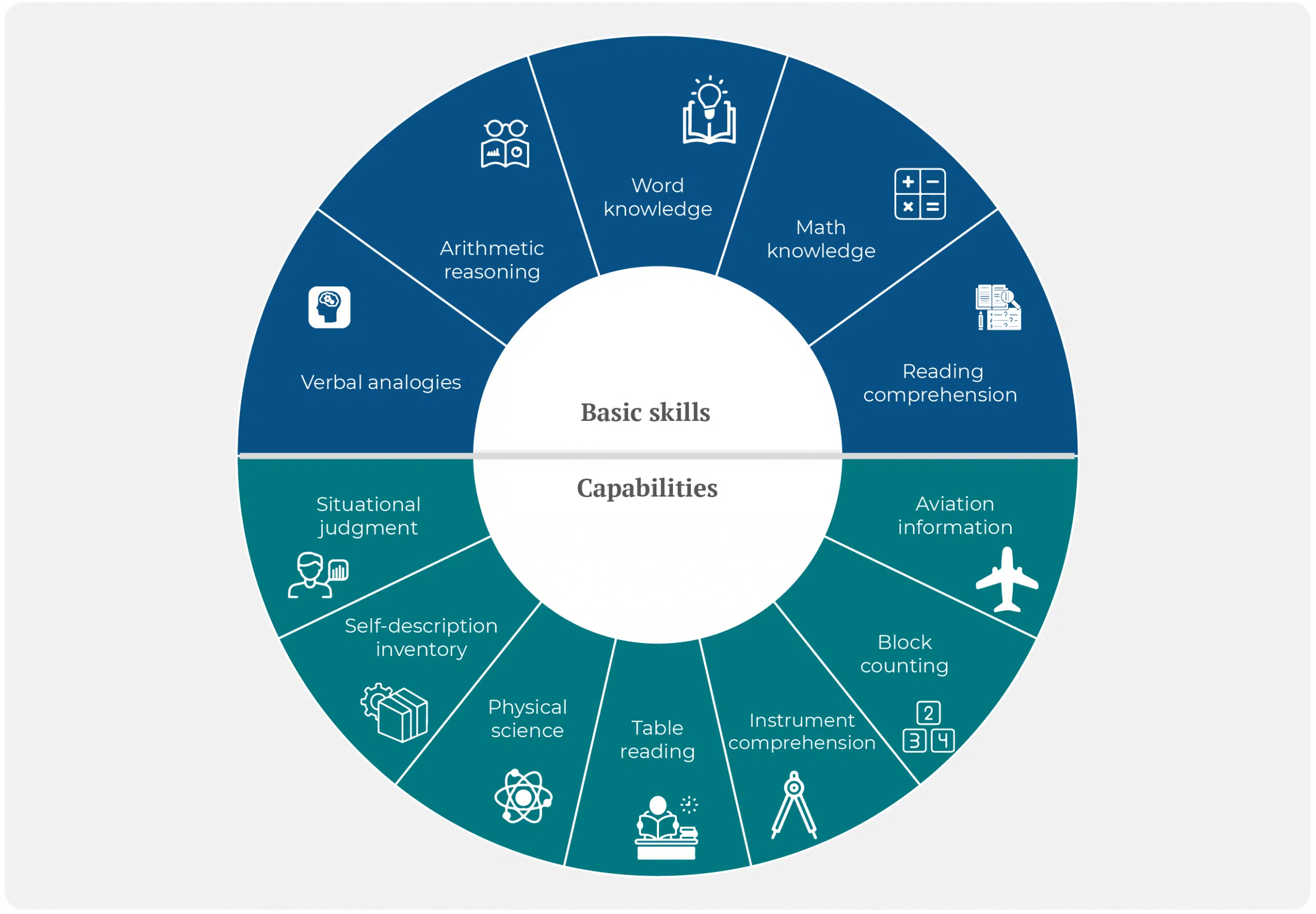
There are a total of 516 questions on the AFOQT.
| Subject | Number of questions | Time limit | Time per question |
|---|---|---|---|
| Verbal Analogies | 25 questions | 8 minutes | 19 seconds |
| Arithmetic Reasoning | 25 questions | 29 minutes | 69 seconds |
| Word Knowledge | 25 questions | 5 minutes | 12 seconds |
| Math Knowledge | 25 questions | 22 minutes | 52 seconds |
| Reading Comprehension | 25 questions | 38 minutes | 91 seconds |
| Situational Judgment Test | 16 questions | 35 minutes | 131 seconds |
| Self-Description Inventory | 240 questions | 45 minutes | 11 seconds |
| Physical Science | 20 questions | 10 minutes | 30 seconds |
| Table Reading | 40 questions | 7 minutes | 10 seconds |
| Instrument Comprehension | 25 questions | 5 minutes | 12 seconds |
| Block Counting | 30 questions | 5 minutes | 10 seconds |
| Aviation Information | 20 questions | 8 minutes | 24 seconds |
Most of the test is given in multiple-choice format, with the exception of the Self-Description Inventory.
The different sections are combined to measure your skills in 7 different areas: Pilot, Combat Systems Officer, Air Battle Manager, Academic Aptitude, Verbal, Quantitative, and Situational Judgment. For more on this, please see the Results Scale and Interpretation section.
Verbal Analogies
In this section, you will have 8 minutes to answer 25 multiple-choice questions, each with 5 possible answers. There are 5 types of verbal analogies in this test, which measure your ability to reason and see relationships among words. They are:
- Synonym/Definition
- Antonym
- Functional/Relationship
- Classification
- Part-to-Whole
Your Verbal Analogies score will be used as part of the following composites: Air battle manager, academic aptitude, and verbal.
Winning Tip for Verbal Analogies
Identify the parts of speech or the tense in each analogy, and ensure that your answers align. For example, if the analogy shows the relationship between a verb and an adjective, the correct answer will show the same relationship in the same order.
AFOQT Verbal Analogies Sample Question
INSULT is to AGGRAVATION as…
- DEMONSTRATION is to RIOT
- DESTINY is to SOLUTION
- RIDDLE is to DISAMBIGUATION
- EMBRACE is to MITIGATION
- NEGATION is to ERUPTION
The correct answer is EMBRACE is to MITIGATION.
Explanation: The analogy underlying this question is A is an action that may lead to a typical response B.
The example: if someone INSULTS someone else, it typically leads to AGGRAVATION of the situation (fight/discontent/etc.)
The correct option: if someone EMBRACES someone else, it may lead to MITIGATION of stress/wrath/etc.
Why the distractors are not the correct answer:
Option A – RIOTS may happen during DEMONSTRATIONS, but they are not the typical outcome of demonstrations.
Options B & E – cannot be naturally associated with the provided example
Option C – a RIDDLE typically makes things more ambiguous. DISAMBIGUATION means that things become less ambiguous.
Arithmetic Reasoning
In this section, you have 29 minutes to answer 25 multiple-choice questions, each with 5 options for answers. The questions are word problems, and the directions include a formula sheet where needed.
Your Arithmetic Reasoning scores will be used as part of the following composites: academic aptitude and quantitative.
Winning Tip for Arithmetic Reasoning
Read each question carefully to identify what is being asked of you. Some questions can be confusing.
AFOQT Arithmetic Reasoning Sample Question
A football game made $1,300 from tickets. If tickets were sold at either $2 or $4.5, and an equal number of each ticket were bought, how many $2 tickets were bought?
- 175
- 185
- 220
- 200
- 160
The correct answer is 200.
Explanation: This question tells us that a total of $1,300 was collected by selling two types of tickets—$2 tickets and $4.50 tickets—in equal numbers. We need to find how many $2 tickets were sold. Let X be the number of each type of ticket.
- Set up the equation:
($2*X) + ($4.50*X) = $1,300
Combine like terms:
(2+4.5) X = 6.5 X = 1,300 - Solve for X:
X = 1,300 / 6.5
Because dividing by 6.5 can be tricky, multiply the numerator and denominator by 2 to get:
1,300 * 2 / 6.5 * 2 = 2,600 / 13 = 200 - Interpret the result:
X = 200 means 200 $2 tickets were sold.
Tips for a quick solution:
- If you see two ticket prices with the same quantity, you can add the prices first:
2 + 4.5 = 6.5.
Word Knowledge
This section measures your knowledge of words and their meanings. You will be given a word and asked to choose which of the five options is closest in meaning to the original word. You will have 5 minutes to answer 25 multiple-choice questions.
Your Word Knowledge score will be used as part of the following composites: combat systems officer, academic aptitude, and verbal.
Winning Tip for Word Knowledge
There is no context for the words in this section. If you aren’t immediately familiar with a word, imagine using it in a sentence and see if any of the options fit into the sentence.
AFOQT Word Knowledge Sample Question
Which word is most different in meaning than the other words?
- advocate
- champion
- proponent
- supporter
- adversary
The correct answer is adversary, meaning an enemy or opponent.
All the other words mean to back someone in a manner that is helping. An advocate is someone who defends or maintains a cause or a group. A champion is someone who battles for another’s rights or honor. A proponent is someone who argues in favor of something. A supporter is someone who promotes the interests of a person.
Math Knowledge
You have 22 minutes to complete 25 multiple-choice math questions. This section measures your knowledge of mathematical terms and principles. Make sure to learn the definitions of the following terms:
- Tangent
- Parallel
- Perpendicular
- Integer
- Rational/irrational number
- Mixed number
- Fraction
- Reciprocal
You should also be familiar with the following concepts:
- Working with trinomials
- Multiplying and factoring
- Mixed numbers with fractions and decimals
- Order of operations
- Division with decimals
- Standard mx+b equation for a line
Your Math Knowledge score will be used as part of the following composites: Pilot, combat systems officer, air battle manager, academic aptitude, and quantitative.
Winning Tip for Math Knowledge
When possible, try to eliminate potential answers, making it easier to find the right answer. If needed, work out problems on scratch paper.
AFOQT Math Knowledge Sample Question
Simplify the expression:
(x3 + 2) (x3 – x2) – x3 + x4
- x9 + x6 + x4 + 2x3 – x2
- x6 – x5 + x4 + x3 – 2x2
- x6 – x5 + 2x3 – 2x2
- x6 + x5 – x3 – 2x2
The correct answer is x6 – x5 + x4 + x3 – 2x2.
We need to distribute the factors to the terms inside the related parentheses:
| (x3 + 2) (x3 – x2) – x3 + x4 | Remember the FOIL method (First, Out, In, Last) |
| (x3 * x3) + (x3 * -x2) + 2x3 + (2 * -x2) – x3 + x4 | For two exponents of the same base, an + am = an+m |
| x3+3 – x3+2 + 2x3 – 2x2 – x3 + x4 | |
| x6 – x5 + 2x3 – 2x2 – x3 + x4 | Reorder and collect similar terms |
| x6 – x5 + x4 + 2x3 – x3 – 2x2 | |
| x6 – x5 + x4 + x3 – 2x2 |
Tip:
- It is easy to forget about – x3 + x4 at the right as it was not part of the factoring process. Always make sure that you work with all the parts of the polynomial.
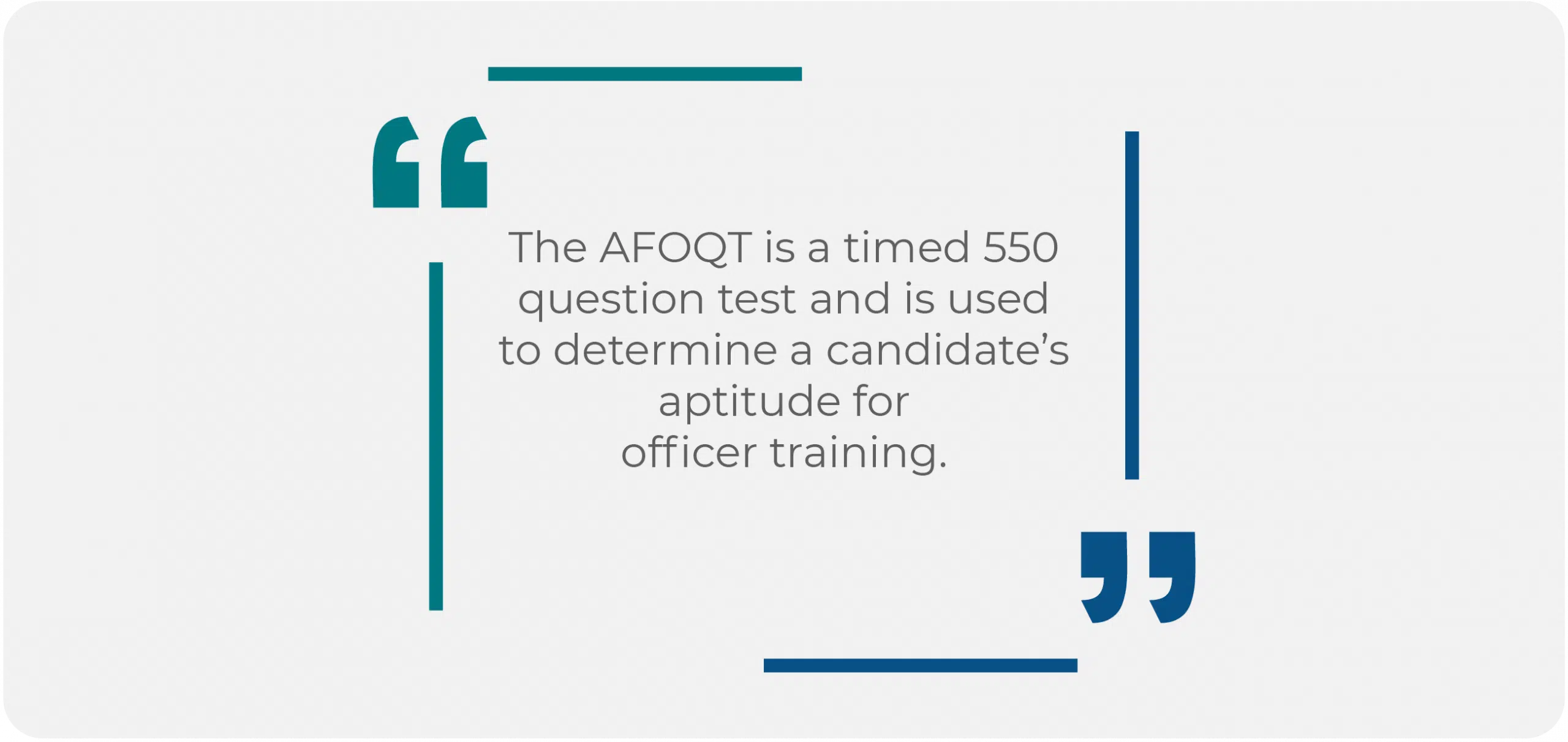
Reading Comprehension
You will have 38 minutes to complete 25 multiple-choice questions in this section. You will be asked to read 5 passages that are 500-600 words long and answer 4-6 questions for each passage.
Your Reading Comprehension score will be used as part of the following composites: Academic aptitude and verbal.
Winning Tip for Reading Comprehension
Read the questions first so you know what information to pay attention to while reading the material. However, double-check your answers against the paragraph before submitting your test.
AFOQT Reading Comprehension Sample Question
There is meaning behind certain colors. Let’s examine the meaning behind two colors that seem to be used quite a bit – red and black. Red is generally associated with energy, power, strength, and determination. Red is commonly used in many sports uniforms because of all the above-mentioned ideas associated with it. Then there is black, which is associated with power. There are other things black is associated with such as evil, death, and elegance, and in sports, the focus is on its meaning of power. These two colors, red and black, are common in almost every NFL team’s uniform. Sixteen out of the thirty-two teams in the NFL have these colors in their uniform. That is very telling considering the meanings of these two colors.
The word “telling” in the paragraph most nearly means:
- Significant
- Speaking
- Obvious
- Out of the ordinary
The correct answer is A.
“Telling” is an adjective that means something significant, which has a striking or revealing effect. It is not obvious but rather indicative of much otherwise unnoticed. While “to tell” has a close meaning to “to speak”, in the context of the paragraph, “telling” has a different meaning.
Situational Judgment
This section evaluates your judgment compared to an officer in the Air Force. For each situation described, you will be asked to identify which of the five options listed is the best response to the situation, and which one is the least effective response.
You will have 35 minutes to answer these 50 scenarios.
Your Situational Judgment score will be used as part of the following composite: Situational judgment.
Winning Tip for Situational Judgment
Before starting this section, imagine yourself as an officer in the Air Force, and base your answers on how an officer should react in these circumstances.
AFOQT Situational Judgment Sample Question
When handing out assignments to employees, which of the following criteria would be the best one for a manager to use?
- Allow employees to choose the assignments they feel they do best
- Assign less critical work to slow employees
- Assign tiring activities to new employees
- Assign tasks based on employee skills
The correct answer is D.
Option A is incorrect because while we do recognize the importance of empowering employees, this is unsustainable. If every employee selected the assignments they wanted to work on, there would be assignments that no one chooses.
Option B is also incorrect because there will be times when it is advantageous to have a slower, more thorough employee work on something critical. Remember, the question is asking for the best criteria.
Option C is incorrect because it is not good practice to dump tiring work on new employees.
Option D is the safest answer. It shows that as a manager you will be utilizing the resources you have available.
Self-Description Inventory
This section measures your personal style and attitudes. You will be given a statement and asked how you feel about the statement, based on a Strongly Agree – Strongly Disagree scale. You will have 45 minutes to respond to 240 statements.
| A | B | C | D | E |
|---|---|---|---|---|
| Strongly Disagree | Moderately Disagree | Neither Agree nor Disagree | Moderately Agree | Strongly Agree |
The Self-Description Inventory is not used in the composite scores.
Winning Tip for Self-Description Inventory
While there are no wrong answers, you can use this section to your advantage. Imagine yourself in the role you want, and base your responses on the way you would feel while in that role.
AFOQT Self-Description Inventory Sample Statement
Read the statement and, based on your first impression, record how well it describes you.
I value creativity and innovation in my work
- Strongly Disagree
- Moderately Disagree
- Neither Agree nor Disagree
- Moderately Agree
- Strongly Agree
The specific personality trait assessed by the statement “I value creativity and innovation in my work” is likely “Creativity.”
Reflection on Creativity and Its Implications
- Agreeing:
Strong agreement reflects an individual who thrives on originality, out-of-the-box thinking, and adaptability. They are likely to excel in roles requiring problem-solving, strategic innovation, or new approaches to challenges, such as research, design, or leadership in dynamic environments. However, they may sometimes struggle with strict rules or repetitive tasks, which could feel limiting to their creative nature. - Neutral:
A neutral response suggests someone who values creativity situationally. They can adapt to creative problem-solving when needed but are also comfortable following established processes. This balance can make them versatile, suitable for roles requiring both innovative thinking and adherence to structured procedures. - Disagreeing:
Disagreement indicates a preference for traditional, proven methods over experimentation or innovation. These individuals may excel in roles requiring consistency, precision, and adherence to established standards, such as technical operations or administrative tasks. However, they might face challenges in rapidly changing or highly creative environments.
Physical Science
In this section, you have 10 minutes to answer 20 multiple-choice questions. Physical science includes astronomy, physics, chemistry, and earth sciences (meteorology and geology).
Your Physical Science score is not used in the composites.
Winning Tip for Physical Science
To do well in this section, you will need a broad understanding of astronomy, chemistry, physics, and meteorology. Remember, this section isn’t used to determine whether you are qualified to serve but to help determine your eligibility for different Air Force jobs.
AFOQT Physical Science Sample Question
A sound which has a frequency below 20 Hz is known as:
- High sound
- Ultraviolet sound
- Low sound
- Loud sound
- Infrasonic sound
The correct answer is: E. infrasonic sound
Infrasonic sounds have a frequency below 20 Hz.
Table Reading
This section measures your ability to read a table quickly and accurately. You will have 7 minutes to answer 40 questions.
Your Table Reading score will be used as part of the following composites: Pilot, combat systems officer, and air battle manager.
Winning Tip for Table Reading
The layout of these questions on the test can be confusing. Practice on a few simulated tests to familiarize yourself with the format so you can move through this section quickly.
AFOQT Table Reading Sample Question
Quickly and accurately read the table below. The X values are the column headers, and the Y values are the row labels. For each question, locate the block where the given X and Y values intersect, note the number in that block, and select it from the answer options.
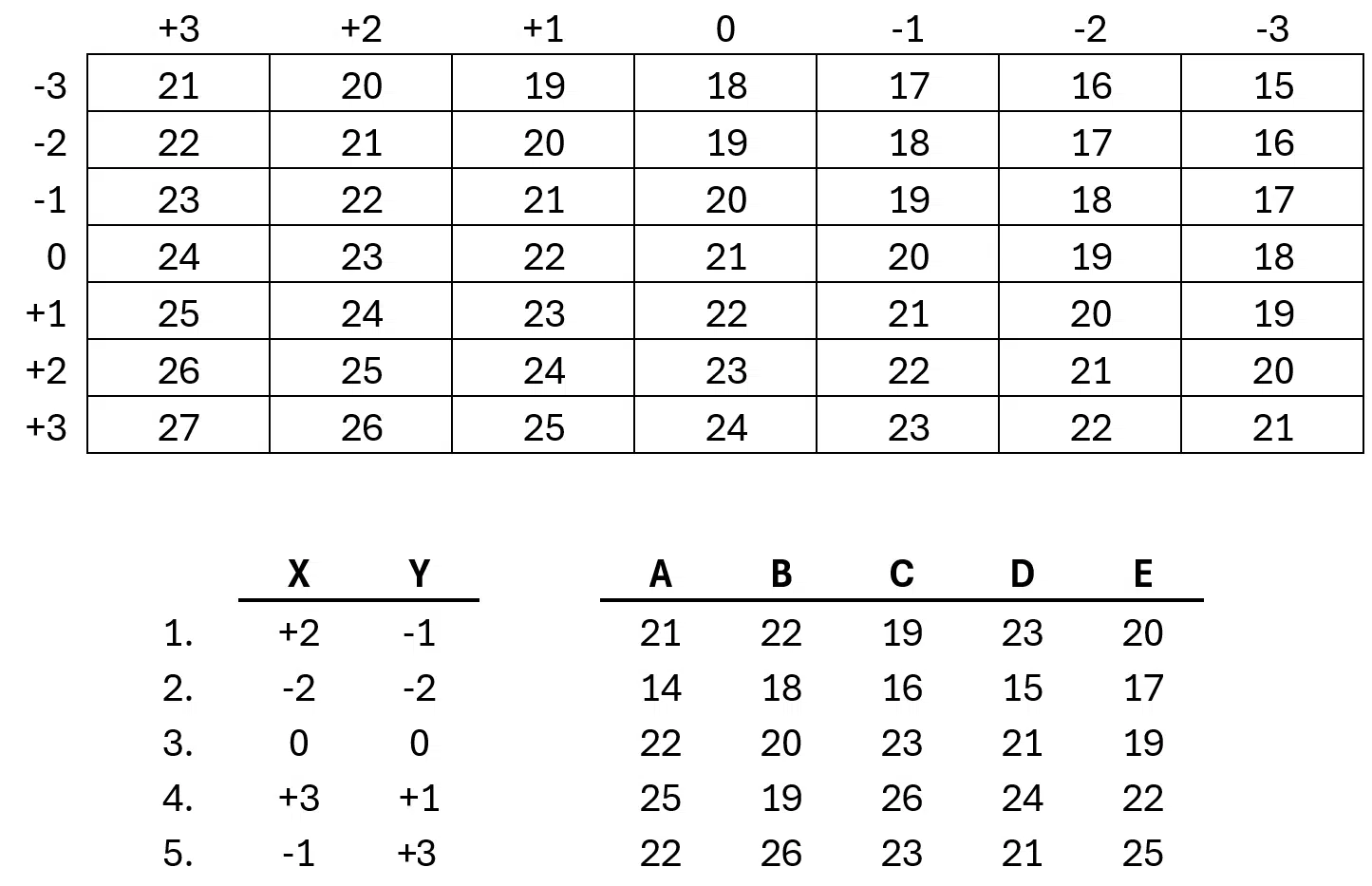
In Table Reading Questions, you’re presented with data in a dense table and asked to locate specific information quickly. You have only 7 minutes to answer 40 questions, so speed and accuracy are crucial. This question format is designed to look complicated and trick you—practice is key to becoming comfortable and succeeding.
The correct answers are as follows:

Quick Tips & Solutions
- Pinpoint Axes Quickly – Identify the horizontal (X) and vertical (Y) axes so you can find the correct row and column without confusion.
- Locate Zero First – Zero-zero is at the center. Dividing the table into quadrants (positive/negative axes) narrows down the area you need to check.
- Use a Pointer Technique – Employ both hands to track. Follow one axis with a finger or pencil so you don’t have to memorize both row and column at once.
- Say It Out Loud – Quietly voice the row and column numbers to avoid mixing them up—especially under time pressure.
- Move On Promptly – Once you confirm the right coordinate or value, proceed immediately to the next question. Staying too long on one item can hurt your overall time.
- Practice One at a Time – Before the actual test, train by answering a single question as quickly as possible, then step away. This helps you develop speed without sacrificing accuracy.
Instrument Comprehension
You will have 5 minutes to answer 25 questions in this section, which measures your ability to determine the position of an airplane in flight. The section contains rules which need to be used throughout the section.
Each question shows the artificial horizon and a compass. You will be asked to determine which of the four planes matches the instruments.
Your Instrument Comprehension score will be used as part of the following composites: Pilot and air battle manager.
Winning Tip for Instrument Reading
While studying, familiarize yourself with the relationship between the artificial horizon and the compass.
AFOQT Instrument Comprehension Sample Question
This question tests your ability to determine an airplane’s position using flight instruments. Each question includes:
- Artificial Horizon Dial: Shows climb, dive, and bank angle.
- The horizon line tilts with bank.
- The white pointer indicates the degree of bank.
- The airplane indicator shifts up or down for climb or dive.
- Compass Dial: Displays the airplane’s heading.
Your task:
- Choose the airplane that best matches the instrument readings.
- You are always viewing from the north at the same altitude.
- East is to your right as you view the airplanes.
Select the correct airplane based on its bank, climb/dive, and heading.
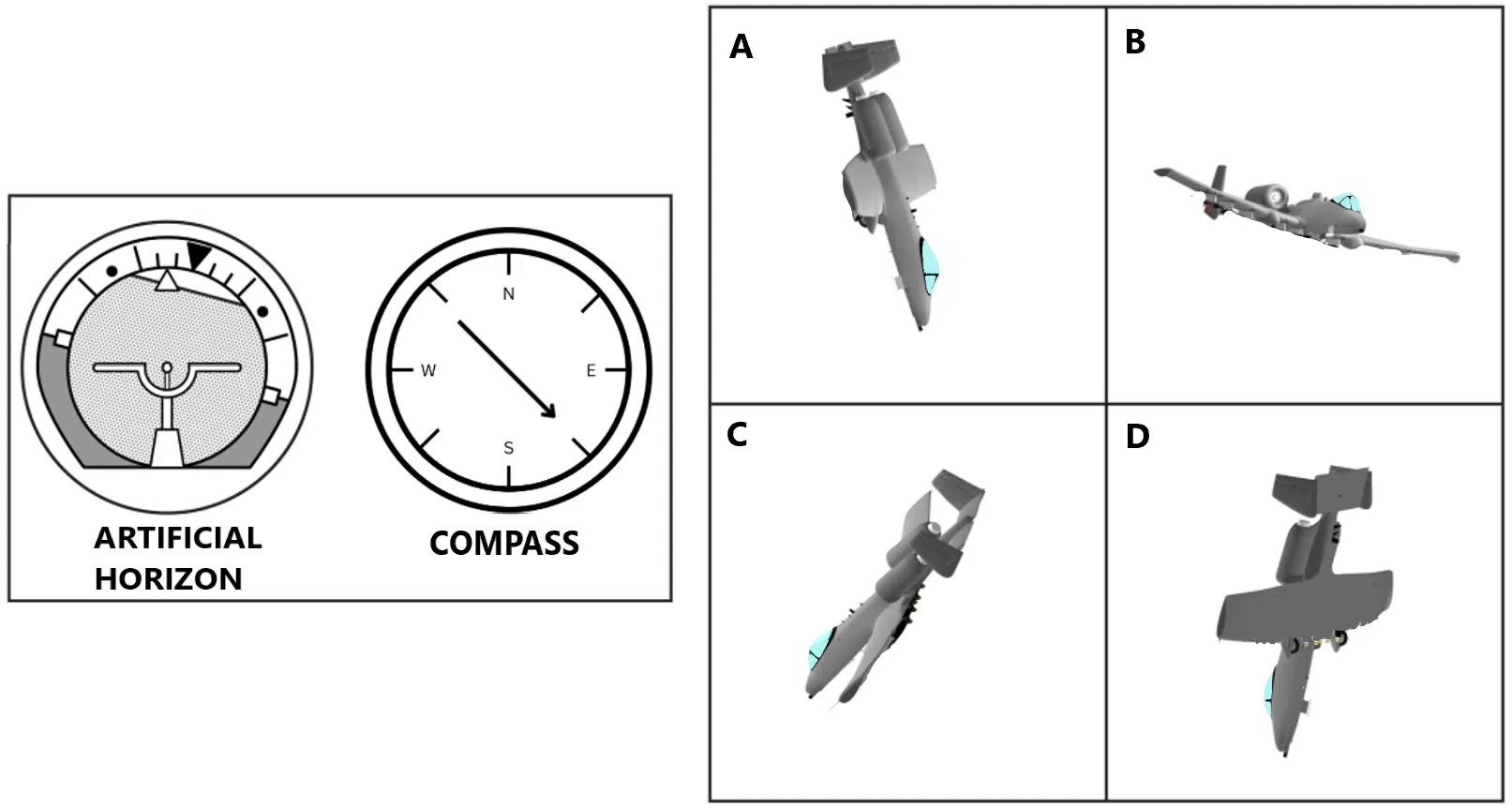
The correct answers is:
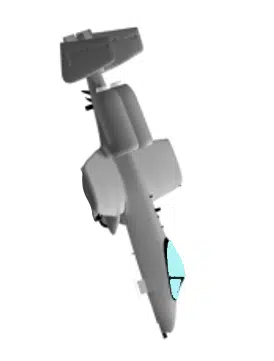
Quick Tips & Solutions
Familiarize yourself with artificial horizon and compass readings in advance. Understanding them well is key to making fast, accurate decisions.
Understand the Artificial Horizon
- The lighter area represents the sky; the darker area represents the earth.
- A “carrot” or arrow typically points “up” (sky) on the gauge. If the center of the airplane symbol is above the horizon line, you’re climbing. If below, you’re descending.
Check Bank Angle
- If the arrow (or carrot) tilts left, the aircraft is banking right, and vice versa. A level arrow means no bank—straight flight.
Compass Heading
- The compass dial shows your heading in degrees relative to north. If the dial reads “090,” the aircraft is heading east, and so on.
Time Management
- Speed is crucial. Answer each question by quickly matching the pitch (up or down) and roll (left or right) with the compass heading. Don’t linger—trust your instruments and move on.
Be Consistent
- The subtest uses the same plane and viewpoint for every question, so once you know the rules (e.g., arrow orientation, compass labeling), apply them uniformly to save time.
Practice Makes Perfect
- Familiarize yourself with artificial horizon and compass readings in advance. Understanding them well is key to making fast, accurate decisions.
Block Counting
This section measures your ability to see into a 3-dimensional pile of blocks. You will be asked to identify the number of blocks that touch the block you are being asked about. You have 5 minutes to answer 30 questions.
Your Block Counting score will be used as part of the following composites: Combat systems officer and air battle manager.
Winning Tip for Block Counting
You don’t have much time in this section, so count quickly. Make sure not to forget about blocks that may be beneath the block you are counting.
AFOQT Block Counting Sample Question
Determine how many blocks the numbered block touches.
Blocks only touch if their faces connect—corner touches don’t count.
Not all blocks are the same size and shape.
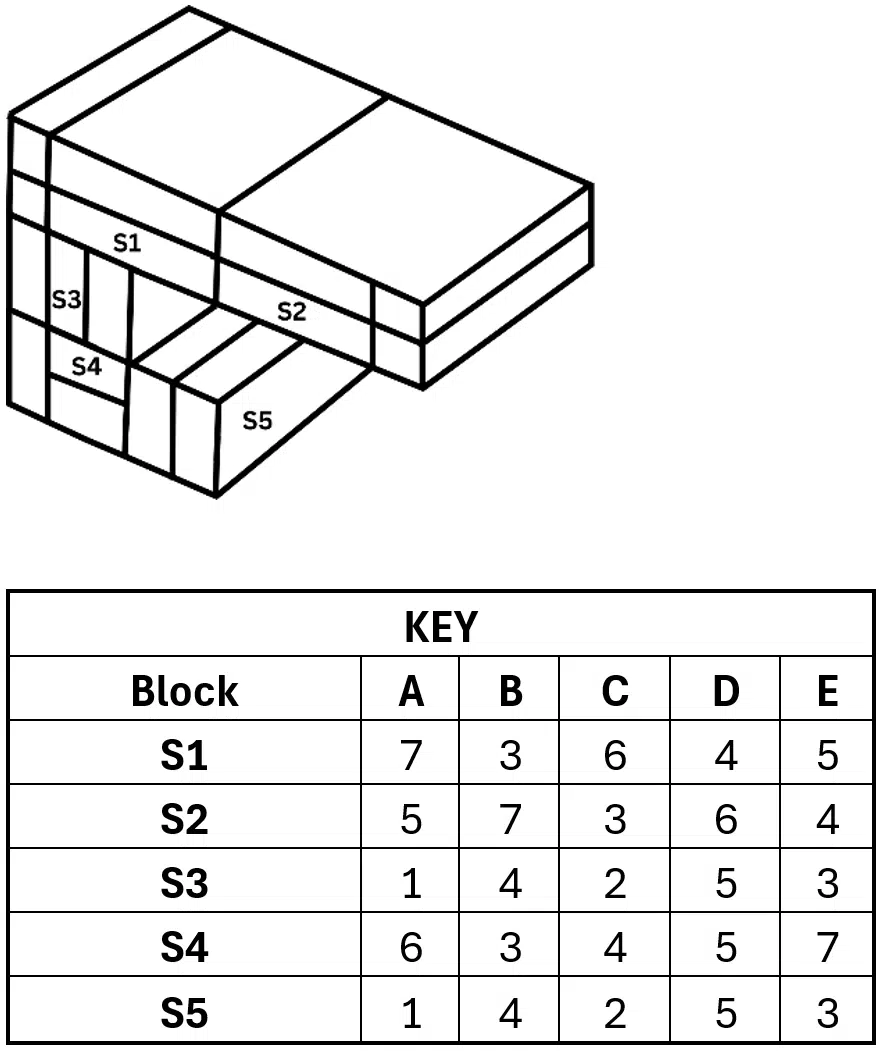
The correct answers are:
E, C, B, D, A
- S1 – E (5)
- S2 – C (3)
- S3 – B (4)
- S4 – D (5)
- S5 – A (1)
In this block-counting question, you must determine how many blocks come into contact with a specific block labeled S. By systematically checking each side—top, left, right, and bottom—you avoid double-counting or missing hidden blocks.
- S1 touches 5 blocks.
- One above, one on each side, two below.
- S2 touches 3 blocks.
- One above, one on each side, none below.
- S3 touches 4 blocks.
- One above, one on each side, one below.
- S4 touches 5 blocks.
- Two above, one on the left, one below.
- S5 touches 1 blocks.
- None above, one on the left, none below.
- Trick: Due to the floating formation, from a glance you may think S5 is touching S2(above).
Tips for a Quick Solution:
Guessing Strategy: In multiple-choice settings, the correct answer often isn’t the extreme high or low. If rushed, pick a middle number to increase your chances.
Divide and Conquer: Focus on one block at a time, listing what’s above, below, and on each side.
Watch for Hidden Blocks: Sometimes blocks are partially obscured or underneath others.
Track Carefully: If allowed, mark blocks off as you count; this helps avoid double-counting.
Aviation Information
This section measures your knowledge of aviation. You will either answer questions or fill in the blanks for questions relating to flying a plane. You must answer 20 questions in 8 minutes.
Your Aviation Information score will be used as part of the following composites: Pilot and air battle manager.
Winning Tip for Aviation Information
You have some time in this section, so read the questions carefully and answer as quickly as you can.
AFOQT Aviation Information Sample Question
When an aircraft descends below its glide slope on an ILS (Instrument Landing System) approach, which indicator would signal this deviation?
- The vertical speed indicator
- The glide slope indicator
- The heading indicator
- The attitude indicator
- The altimeter
The correct answer is B. The glide slope indicator.
Explanation:
Glide Slope Indicator: Part of the ILS system, it specifically displays whether an aircraft is above, on, or below the ideal glide path. A deviation below the glide slope will be immediately apparent on this indicator.
Why Other Options Are Incorrect:
- (A) Vertical Speed Indicator: Shows rate of climb or descent, not exact glide slope deviation.
- (C) Heading Indicator: Reflects the aircraft’s directional heading, unrelated to vertical glide path.
- (D) Attitude Indicator: Displays pitch and roll, but not precise glide slope alignment.
- (E) Altimeter: Measures altitude above sea level; it doesn’t indicate if the aircraft is on the correct descent profileJet engines produce more thrust.
AFOQT Preparation Strategies
The twelve sections in the AFOQT fall into three different categories.
Category 1
Five sections – Verbal Analogies, Arithmetic Reasoning, Word Knowledge, Math Knowledge, and Reading Comprehension – are required for you to commission – you have to pass them to move forward with the process.
Category 2
The Table Reading, Instrument Comprehension, Block Counting, and Aviation Information sections are used in your composite scores, so doing well is instrumental in opening doors to become a pilot, air battle manager, or other commissioned role.
Category 3
The self-description inventory, situational judgment, and physical science are not part of the composite scores.
Therefore, your preparation focus should be on the five required sections and the sections that you need to pass to get the commission you want.
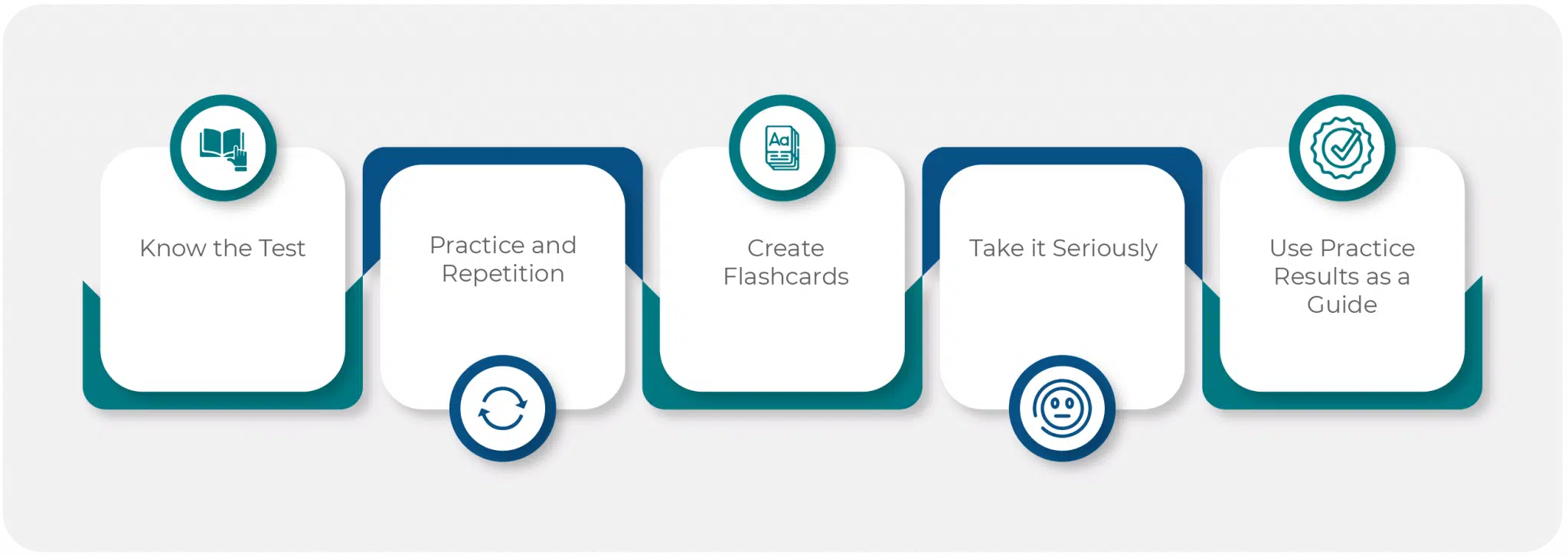
1. Know the Test
Test takers have reported that the time constraints are part of what makes the AFOQT so difficult. One way to save time is by familiarizing yourself with the different sections and instructions. This will give you additional time to focus on the questions rather than trying to understand what is being asked of you.
2. Practice and Repetition
Take practice tests that simulate test conditions. With the new AFOQT, that means finding online courses and practice tests, like those offered by iPrep. If you are going to take a paper version of the test, you can still use online resources to study, as well as buy a study guide book with practice tests included.
3. Create Flashcards
Flashcards help build your knowledge base in a few ways. First, when writing out the cards you commit information to memory. Second, reviewing the cards will build muscle memory, and help you on test day.
4. Take it Seriously
The test is one obstacle in your way to becoming a commissioned officer, so take it seriously. Schedule blocks of time every day in preparation for the test, so you are ready on test day.
5. Use Practice Results as a Guide
After reviewing your practice test results, pay close attention to areas where you struggled. Those should be the areas that you focus your attention on so that you can consistently improve your practice test scores as you get closer to taking the test.
Test Features
AFOQT Test Facts (tl;dr)
- Total of 516 questions
- The test is timed and takes approximately 5 hours to complete, including admin time and breaks
- You must pass the first five sections to be considered for a commissioned officer
- You may retake the test after 6 months. Additional retakes require a waiver.
- Your highest score in any section is the score that is used, regardless of whether it is from your first attempt or any subsequent attempt
- The test is used to determine whether you should be in an officer commissioning program
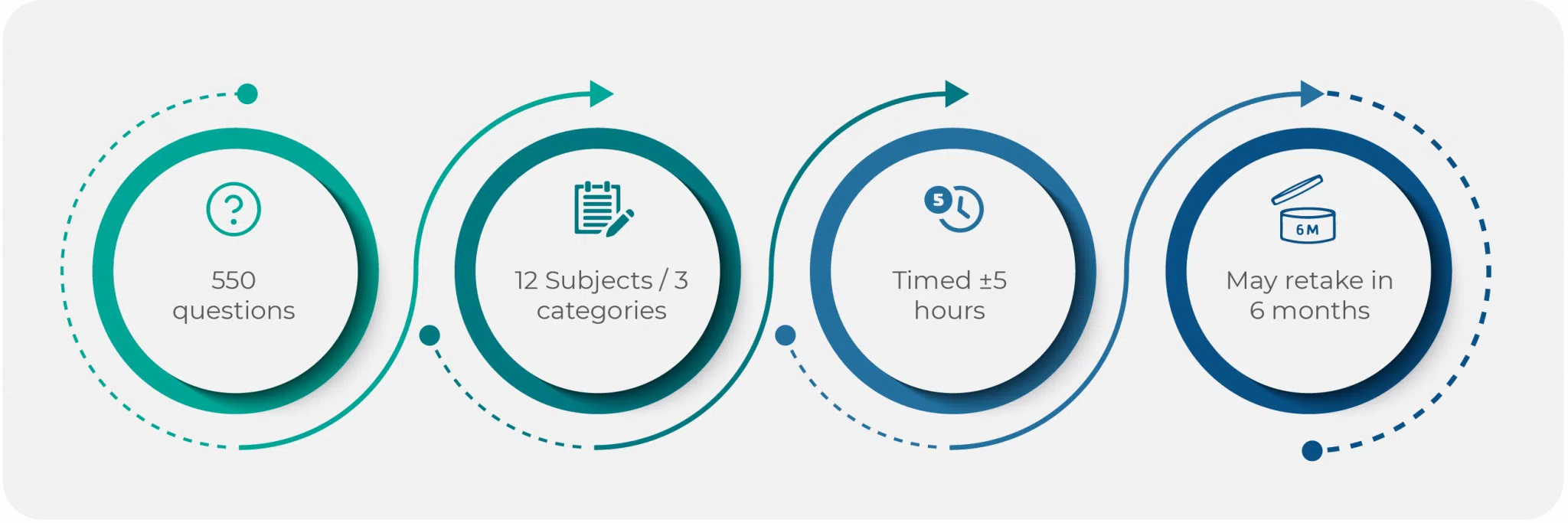
AFOQT vs. ASVAB
Both the AFOQT and the ASVAB are standardized tests used by the military. However, they are used for different purposes.
The ASVAB is used to determine one’s fitness for the military. It is required for any branch that you may enlist in, including the Air Force which requires a score of 36 or higher.
The AFOQT is an Air Force-specific test, used to determine whether you should be in an officer commissioning program.
Validity of AFOQT Scores
As of now, AFOQT Form T scores don’t expire. Tests taken before the updated Form T test were converted and used in personnel decisions. However, at this point in time S From tests are no longer valid.
S Form vs Form T
The AFOQT S Form test was replaced by the Form T test in 2015. For consistency purposes, S Form results have been converted into Form T scores, allowing military personnel to compare scores and use old test scores to make decisions.
eAFOQT
In response to COVID-19, the Air Force recently announced the availability of the electronic Air Force Qualifying Test, or eAFOQT. The eAFOQT covers the same materials as the traditional paper version of the test but is taken on a computer.
AFOQT vs. TBAS test
The Test of Basic Aviation is a test that Air Force pilots and remotely piloted aircraft (RPA) candidates have to take. It measures psychomotor skills learning, spatial ability, and multitasking.
| AFOQT | TBAS | |
|---|---|---|
| Time frame | Approximately 5 hours | 75 minutes |
| Questions | 516 | 48 questions plus tasks that you must complete on a computer |
| Sections | 12 | 5 |
| Audience | All Commissioned officer candidates | Pilots and RPA candidates |
| Format | Paper | Computer |
iPREP: Concise. Focused. What you need.
Sign up
Immediate access
Practice
Online self-paced
Pass
Ace that Test!
Technical Facts
Registering for the AFOQT
There are two ways to register for the AFOQT test.
If you are already enrolled in Air Force Reserve Officers Training Corps (ROTC), you will be required to take the test when you start the Professional Officers Course, during your second year in Air Force ROTC.
If you are not enrolled in Air Force ROTC, you must contact your Air Force recruiter. (To find one near you, visit the official Air Force website.) Your recruiter will determine if you meet the Air Force requirements to take the AFOQT, and if you do, will help you register for the test.
Passing and Failing
Officially, there is no such thing as failing the AFOQT test. However, if your scores don’t meet the minimum threshold, you will not be able to become an officer.
Results Scale and Interpretations
In the AFOQT, your raw score is based on the number of correct answers you had in each section. Those scores are then normalized into a score, allowing military personnel to determine your fit for a role.
When you have finished the test, your scores will be combined, and you will receive scores in five categories. They are:
- Quantitative
- Pilot
- Verbal
- Academic Aptitude
- Navigator Technical
| SUBTEST | Items | Pilot | CSO | ABM | Academic | Verbal | Quantitative | Situational judgment |
|---|---|---|---|---|---|---|---|---|
| Verbal Analogies | 25 | ✓ | ✓ | ✓ | ||||
| Arithmetic Reasoning | 25 | ✓ | ✓ | |||||
| Word knowledge | 25 | ✓ | ✓ | ✓ | ||||
| Math Knowledge | 25 | ✓ | ✓ | ✓ | ✓ | ✓ | ||
| Reading Comprehension | 25 | ✓ | ✓ | |||||
| Situational Judgment Test | 50 | ✓ | ||||||
| Table Reading | 40 | ✓ | ✓ | ✓ | ||||
| instrument Comprehension | 25 | ✓ | ✓ | |||||
| Block Counting | 30 | ✓ | ✓ | |||||
| Aviation Information | 20 | ✓ | ✓ |
Your Verbal score is made up of results from Verbal Analogies, Word Knowledge, and Reading Comprehension. Your Quantitative score is based on results from Arithmetic Reasoning and Math Knowledge.
You will need a minimum score of 15 for Verbal and 10 for Quantitative.
How Scores are Used
Your AFOQT score is used by military evaluators in making personnel decisions. Your scores in the different sections are used to create composite scores. As seen in the table above, your scores in Math Knowledge, Table Reading, Instrument Comprehension, and Aviation Information form your Pilot Composite Score. That score is then combined with your Navigator Verbal and Quantitative Composite Scores to give you your AFOQT Pilot score.
For pilots, the AFOQT is just one component of the Pilot Candidate Selection Method (PCSM). The AFOQT is combined with the TBAS scores and the total number of flight hours to produce a PCSM score.
Scores are normalized against other candidates and presented on a scale of 1-99. A PCSM score of 99 means your score is higher than all other candidates.
| TBAS Based PCSM Score |
| PCSM Score | TBAS Test Date | Flight Hours | AFOQT Pilot | AFOQT Test Date | AFOQT Version |
|---|---|---|---|---|---|
| 81 | 4/10/2019 | 64 | 94 | 4/9/2019 | T/1 |
Minimum Scores
The following tables show the minimum scores you need for specific roles. However, it’s important to remember that the Air Force selects candidates based on several factors. Scoring above the minimum requirements should enhance your candidacy.
| Pilot | Combat Systems Officer (CSO) /Navigator | Air Battle Manager (ABM) | |
|---|---|---|---|
| Verbal Composite | 15 | 15 | 15 |
| Quantitative Composite | 10 | 10 | 10 |
| Pilot Composite | 25 | 10 | N/A |
| CSO/Navigator Composite | 10 | 25 | N/A |
| ABM Composite | N/A | N/A | 25 |
When Do I See My Score?
Scores are typically available 8-19 days after completing the test.
AFOQT FAQs
The AFOQT test is used by the U.S. Air Force to determine whether someone is a candidate to be a commissioned officer.
The AFOQT is a multiple-choice test that will challenge your math and verbal skills, as well as specialized knowledge relating to flight. The test includes a 240-question personality test and a set of scenarios with options for you to determine which is the most and least effective.
The AFOQT test is hard, as it covers a wide range of materials, and has challenging time constraints. However, with the right preparation, you should be able to get through the materials.
Both the AFOQT and ASVAB are important tests, but the AFOQT is harder as it covers more areas of knowledge.
The AFOQT has 516 questions. Most are multiple-choice, although the 240-question personality test asks you to show, on a scale of 1-5, how much you agree with a statement. The Situational Judgment test presents 50 scenarios, and you will need to choose the most and least effective approaches to handling a situation.
You will need to score a 15 on your verbal and 10 on quantitative sections.
At this time, there is no expiration date on AFOQT Form T tests.
If your scores are below 15 verbal and 10 quantitative, or if you want to improve your scores, you can retake the test after 150 days. While it is possible to take the test for a third time if you are still not pleased with your results, you will need to get a special waiver from the Air Force.
Yes, you can retake the AFOQT after 150 days.
The AFOQT does not have a passing score. However, you will need to score a minimum of 15 on the verbal section and 10 on the quantitative section to be eligible for a commissioned officer role.
The AFOQT is a difficult test because it covers a wide range of topics within a tight time frame. However, with studying and practice, you should be able to do well on the test.
The best way to study is to start with a practice test to identify your weaknesses, and then study those sections. You will want to schedule time every day for preparation, using online courses like those offered by iPrep, or study guides that you can order from Amazon.
The AFOQT has story problems, math terms, and concepts. You should be familiar with multiplication, factoring, division, order of operations, fractions, and decimals.
You may not use a calculator on the AFOQT.
Your AFOQT is just one element that is used in determining your options within the Air Force. However, if you do poorly on the test you could close options. It is in your best interests to do well on the test.
Most of the test questions are multiple-choice. The personality test asks you to state whether you agree with a statement on a scale of 1-5.
AFOQT Test Tips
The AFOQT takes over 5 hours to complete. You’ll have 2 breaks during the test, but the extended time period means you’ll need to be at your best for quite some time. Here are some tips to help you perform your best on test day.
1. Don’t leave blank answers
You don’t lose points for getting answers wrong, so if you don’t have a clue, try to eliminate some options. That way, you’ll increase the chances that your guess is correct.
2. Follow your strengths
Try to answer the questions you know first, and then come back to the questions where you are unsure. However, you need to be really careful with this strategy. Remember, most versions of this test use pen and pencil, so if you are jumping around from one question to the next, make sure to fill your answers into the answer sheet on the correct line.
3. Take care of yourself
Get a good night’s sleep before taking the test, and eat a sensible, healthy meal. You want your brain operating at its peak, and you don’t want to spend the test waiting for a bathroom break.
4. Take a prep course and an AFOQT practice test
Even if you think you know the material, it’s always a good idea to familiarize yourself with the style and content of the test beforehand. That way you will feel comfortable as you move through the twelve sections of the test.
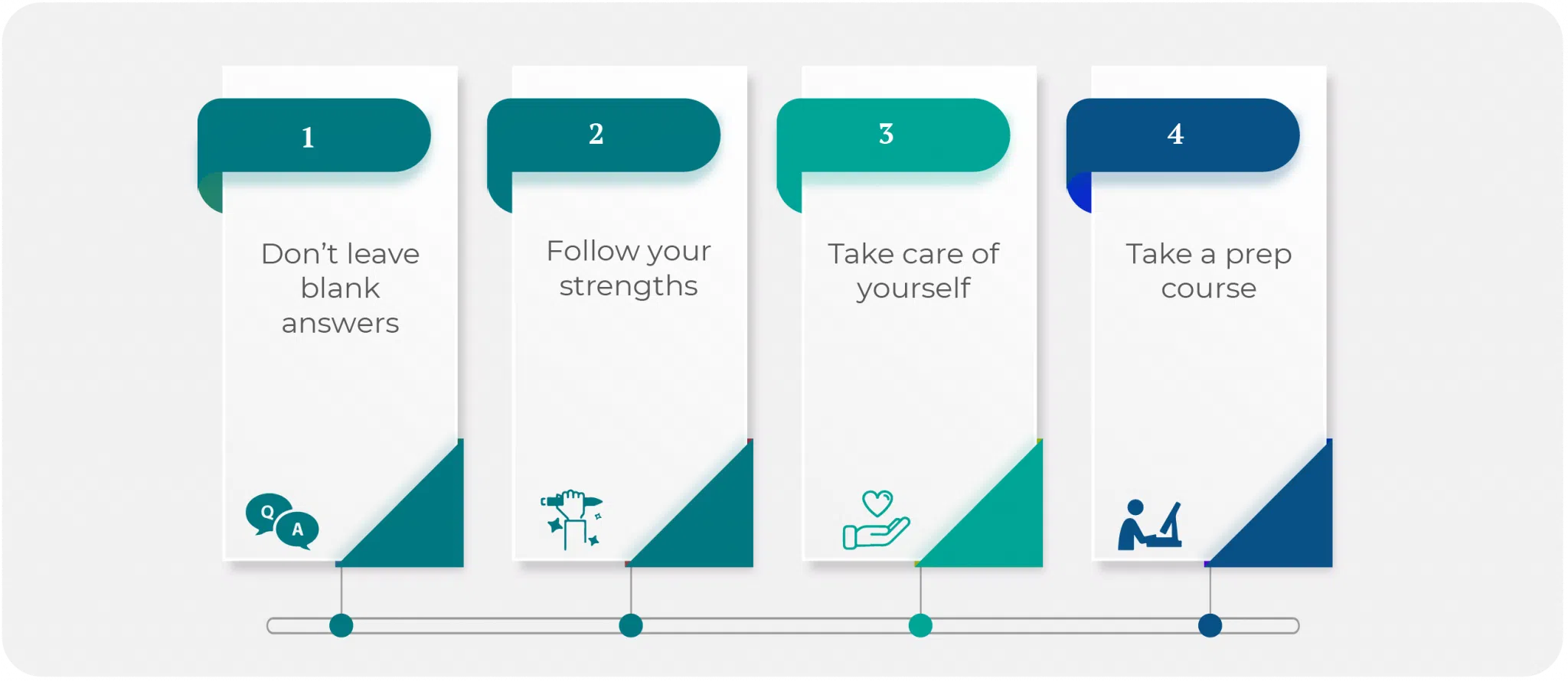
Administration
- Test Location: Cadets in an ROTC program take the AFOQT as part of their coursework. Those who are not in the military but would like to join will take the test at the nearest Military Entrance Processing (MEPs) location.
- Test Schedule: Cadets in an Air Force ROTC program will take the AFOQT during their sophomore year. Civilians looking to take the test will be advised by their recruiter.
- Test Format: Pencil and paper. Due to COVID-19, the Air Force has announced an e-AFOQT which is done on a computer.
- Test Materials: Pencil and scratch paper
- Cost: Covered by the recruiter
- Retake Policy: Once after 150 days. An additional retake requires a special Air Force waiver.
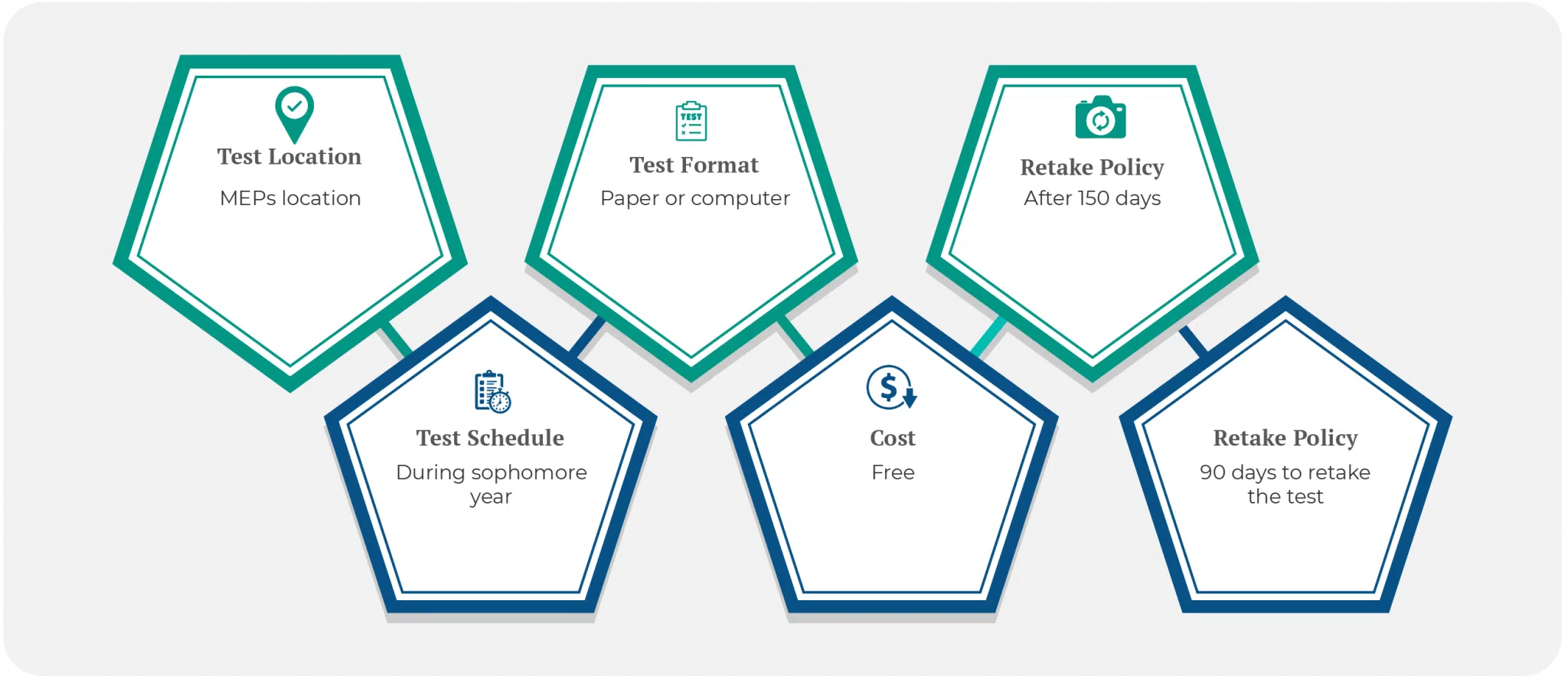
Test Provider
The test was developed and is administered by the United States Air Force. The AFOQT is taken at a Military Entrance Processing Station (MEPS) or as part of an Air Force ROTC curriculum.
Information Sources
Disclaimer – All the information and prep materials on iPrep are genuine and were created for tutoring purposes. iPrep is not affiliated with the U.S. Air Force, which is the owner of the AFOQT, or any companies or trademarks that were mentioned above.
Free AFOQT practice test: Get to know what the AFOQT will be like by practicing with these sample questions:
Question 1 of 12 – Verbal Analogies
HUMOR is to LAUGH as…
- BREEZE is to DRIFT
- CONTEMPLATION is to WANDER
- CONCUSSION is to INJURY
- THERAPY is to ALLEVIATE
- INCITEMENT is to RETRACT
The correct answer is BREEZE is to DRIFT.
Explanation: The analogy underlying this question is A may make something B.
The example – humor may make people laugh.
The correct option – a breeze may cause things (leaves, feathers, etc.) to drift on it. While “waft” may be the more accurate verb, “drift” still adheres to the meaning and structure of the analogy.
Why the distractors are not the correct answer:
Option B – contemplation may make one wonder, with an “O” The word that appears in this option is wander.
Option C – a concussion is a type of injury. A concussion doesn’t make an injury.
Option D – therapy may alleviate pain or stress. However, this pair of words doesn’t maintain the structure of the analogy. The second word of the analogy represents something that happens to something in light of the first word. In option D, therapy directly causes alleviation, therefore it is not the right analogy.
Option E – incitement is supposed to motivate, not to make someone retract from something.
Tips for a quick solution:
Word analogies always maintain the part of speech of each of the words in the analogy. For example, if the original example is “NOUN is to VERB,” the correct answer must also be in the form of “NOUN is to VERB.” If you notice that any of the answers is in a different form (e.g. “NOUN is to NOUN”), you can immediately eliminate it as a possible answer. At times, this technique can immediately remove 2-3 options.
Nonetheless, in some cases, a word might have two meanings which belong to different parts of speech. Many verbs are also nouns. Many nouns are also adjectives. Considering that, use the above-mentioned tip only in cases where you are certain of the part of speech of every word.
Question 2 of 12 – Math Knowledge
Consider the following formula:
(3A – (2B + C)) – 2 = BC + A
If B = 5 and C = 6, what is the value of A?
- 6
- 12
- 16
- 24
The correct answer is 24.
In order to solve this question correctly, you need to remember the order of operations (PEMDAS):
- Parentheses
- Exponents
- Multiplication/Division
- Addition/Subtraction
In addition, you should remember that if a minus sign precedes parentheses, it applies to all the values within the parentheses and not only to the first value. Although it is not necessary to apply this to this question, the solution below includes this demonstration.
In order to find a solution, we need to isolate A.
| (3A – (2B + C)) – 2 = BC + A | Remove the inner parentheses |
| (3A – 2B – C) – 2 = BC + A | Place values B = 5; C = 6 |
| (3A – 2*5 – 6) – 2 = 5*6 + A | Multiplication within the parentheses first. As there is no factor to the parentheses, it can be resolved. |
| 3A – 10 – 6 – 2 = 30 + A | Note that subtraction must be done left to right and do not forget that there is a minus sign before the number 10 |
| 3A – 18 = 30 + A | Collect As at the left and numbers at the right |
| 3A – A = 30 + 18 | |
| 2A = 48 | Divide by 2 to find A |
| A = 24 |
Question 3 of 12 – Word Knowledge
Which word is most different in meaning than the other words?
- flammable
- insidious
- combustible
- ignitable
- inflammable
The correct answer is insidious, meaning proceeding in a gradual, subtle way, but with harmful effects.
All the other words mean that something can be burned. Although the prefix “in-” is used before the word flammable, this does not mean that the item cannot light on fire suddenly. However, due to this confusion, it is more common to state that something is flammable. Inflammable means can ignite without an external fire source like a match. Insidious may resemble in sound “incendiary,” which also means flammable.
Question 4 of 12 – Arithmetic Reasoning
A restaurant served 170 meals on a busy evening. This was 200% of the number of meals they usually serve on a regular evening. How many meals do they usually serve on a regular evening?
- 370
- 340
- 85
- 75
- 30
The correct answer is 85.
Explanation:
This is a “reverse percentage” type of question.
Let the usual number of meals be x. The problem tells us that the number of meals served on the busy evening, 170, is 200% of the usual number of meals.
Since 200% is equivalent to multiplying by 2, we can write this relationship as:
170 = 200% * X
This equation represents the relationship described in the problem.
If possible, the best way is to convert the percent value to fraction or decimal form.
In this case, 200% means “two times”, which simply means to multiply a value by 2. Using this conversion, you can simply solve:
170 = 200% * X convert % value
170 = 2 * X divide both sides by 2
170/2 = X
X = 85
Tips for a quick solution:
Suppose you do not remember the percentage-fraction conversion by heart. In that case, it is usually worthwhile trying to convert the percentage value to a fraction with a denominator of 100 and then reduce it to the smallest numbers.
In our case, 200% is 200/100, and if reduced by 100, you get 2.
Question 5 of 12 – Reading Comprehension
There is meaning behind certain colors. Let’s examine the meaning behind two colors that seem to be used quite a bit – red and black. Red is generally associated with energy, power, strength, and determination. Red is commonly used in many sports uniforms because of all the above-mentioned ideas associated with it. Then there is black, which is associated with power. There are other things black is associated with such as evil, death, and elegance, and in sports, the focus is on its meaning of power. These two colors, red and black, are common in almost every NFL team’s uniform. Sixteen out of the thirty-two teams in the NFL have these colors in their uniform. That is very telling considering the meanings of these two colors.
Black is a common color for sports uniforms because it reflects positively on the __________ of the team.
- Elegance
- Strength
- Power
- Evil
The correct answer is C.
The second paragraph focuses on the traits associated with the red and black colors. You should look for the traits associated with black to answer the questions.
Of the four answers, three are associated with black – elegance, power, and evil. However, the paragraph emphasizes that in the context of sports, black is chosen as a uniform color for its association with “power.” “Power” is also associated with red. If you are not a careful reader, it might lead you to eliminate it from being the correct answer.
Tip: As you may assume that colors should reflect on positive, sports-related traits, answers B and C strike as better candidates for the correct answer. If you reach such a conclusion, it might be sufficient to search for those specific words in the text and to try to affirm or contradict them as the correct answer.
Question 6 of 12 – Situational Judgement
One of your team members complains that she is being overworked compared to her coworkers and is having trouble meeting deadlines. You should:
- Ask if she is dealing with other pressures from outside the workplace
- Review her recent assignments to see if she is right
- Tell her that everyone on the team is swamped with work, and it is being assigned equally
- Tell her she is the most capable member of the team, which is why she gets more assignments than her coworkers
The correct answer is B.
Option A is incorrect because it is insulting and implies that she is misunderstanding the situation.
Option C is wrong because it shows that you assume that you are correct.
Option D is incorrect because it might seem to them to be a punishment rather than a reward.
Additionally, the question didn’t tell you that the employee was a top performer, so choosing this answer requires that you make that assumption.
Option B shows that you are objective and willing to investigate her complaint.
Question 7 of 12 – Self-Description Inventory
Read the statement and, based on your first impression, record how well it describes you.
I enjoy analyzing complex problems before taking action
- Strongly Disagree
- Moderately Disagree
- Neither Agree nor Disagree
- Moderately Agree
- Strongly Agree
The specific personality trait assessed by the statement “I enjoy analyzing complex problems before taking action” is “Analytical Thinking.”
Reflection on Analytical Thinking and Its Implications
- Agreeing:
A strong agreement reflects a highly analytical individual who values logic, structure, and understanding before acting. These candidates are likely detail-oriented, strategic, and deliberate, excelling in roles that require thorough planning or problem-solving, such as technical or intelligence positions. However, they might be perceived as overly cautious or slow to act under time pressure. - Neutral:
A neutral response suggests flexibility—someone who can analyze problems when necessary but is also comfortable making decisions with limited information. These individuals balance analysis and action, which is advantageous for roles requiring adaptability and quick thinking, such as operational leadership. - Disagreeing:
Disagreement indicates a preference for intuitive or action-oriented decision-making. These individuals are likely quick, decisive, and confident under pressure, making them well-suited for fast-paced or high-stakes roles like piloting. However, they may risk overlooking critical details in complex situations.
Question 8 of 12 – Physical Science
A current supplied by a battery or a cell is an example of:
- Open circuit
- Alternative current
- Closed circuit
- Both AC and DC current
- Direct current
The correct answer is: E. Direct current
Explanation: Direct current (DC) flows constantly in one direction. For example, the current from a battery or a cell is DC current.
Question 9 of 12 – Table Reading
Quickly and accurately read the table below. The X values are the column headers, and the Y values are the row labels. For each question, locate the block where the given X and Y values intersect, note the number in that block, and select it from the answer options.
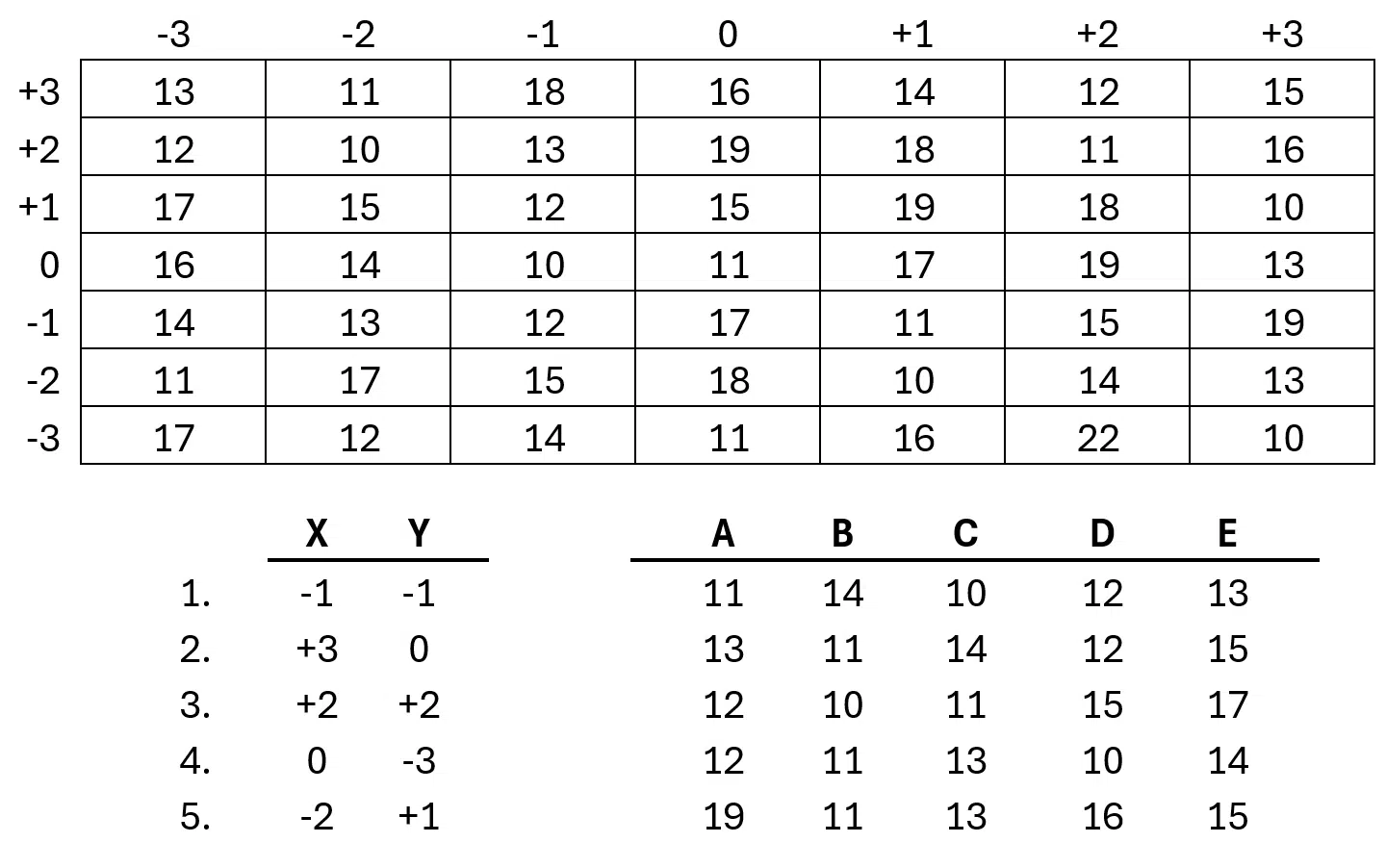
In Table Reading Questions, you’re presented with data in a dense table and asked to locate specific information quickly. You have only 7 minutes to answer 40 questions, so speed and accuracy are crucial. This question format is designed to look complicated and trick you—practice is key to becoming comfortable and succeeding.
The correct answers are as follows:

Quick Tips & Solutions
- Pinpoint Axes Quickly – Identify the horizontal (X) and vertical (Y) axes so you can find the correct row and column without confusion.
- Locate Zero First – Zero-zero is at the center. Dividing the table into quadrants (positive/negative axes) narrows down the area you need to check.
- Use a Pointer Technique – Employ both hands to track. Follow one axis with a finger or pencil so you don’t have to memorize both row and column at once.
- Say It Out Loud – Quietly voice the row and column numbers to avoid mixing them up—especially under time pressure.
- Move On Promptly – Once you confirm the right coordinate or value, proceed immediately to the next question. Staying too long on one item can hurt your overall time.
- Practice One at a Time – Before the actual test, train by answering a single question as quickly as possible, then step away. This helps you develop speed without sacrificing accuracy.
Question 10 of 12 – Instrument Comprehension
This question tests your ability to determine an airplane’s position using flight instruments. Each question includes:
- Artificial Horizon Dial: Shows climb, dive, and bank angle.
- The horizon line tilts with bank.
- The white pointer indicates the degree of bank.
- The airplane indicator shifts up or down for climb or dive.
- Compass Dial: Displays the airplane’s heading.
Your task:
- Choose the airplane that best matches the instrument readings.
- You are always viewing from the north at the same altitude.
- East is to your right as you view the airplanes.
Select the correct airplane based on its bank, climb/dive, and heading.
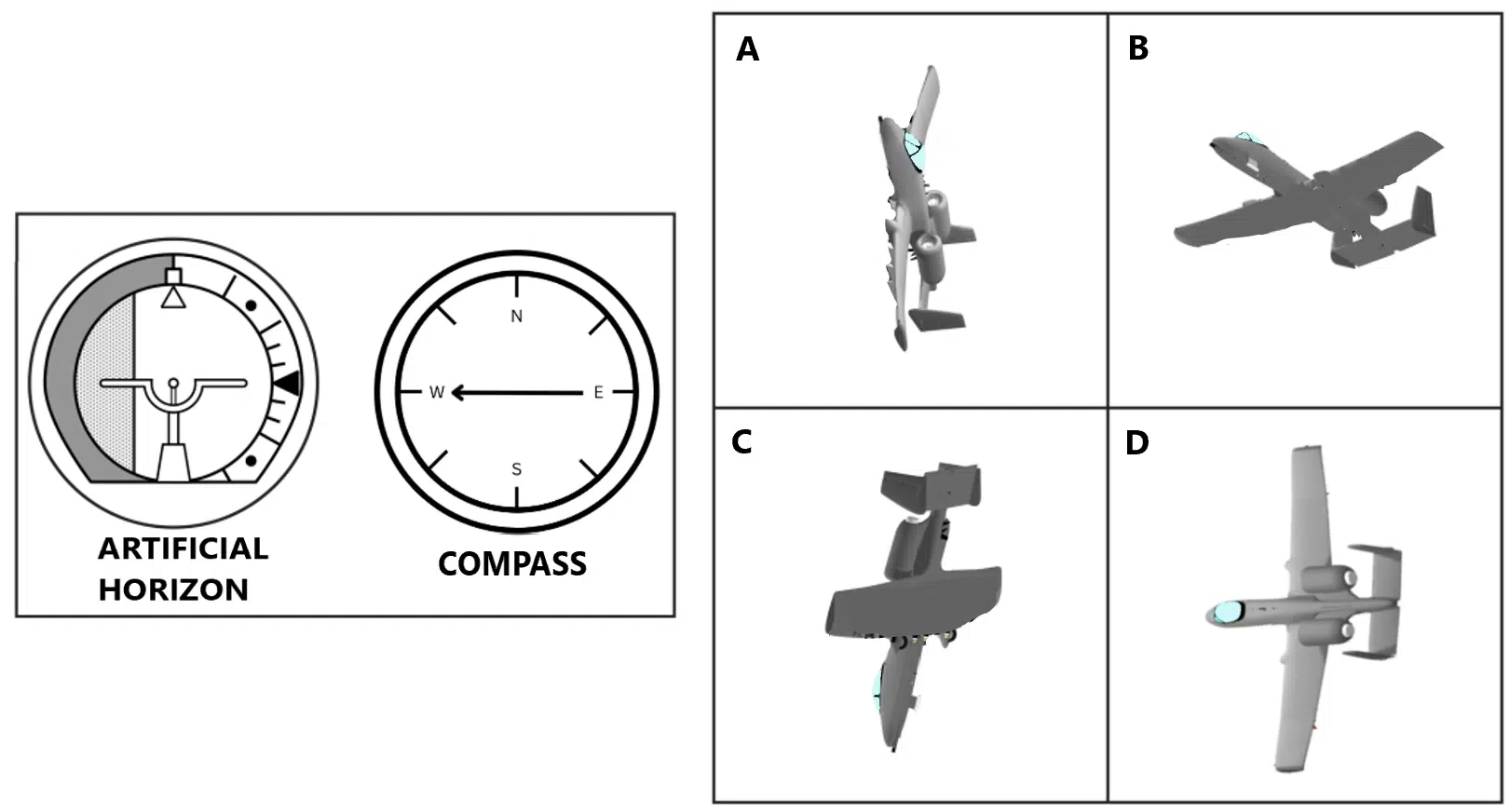
The correct answers is:
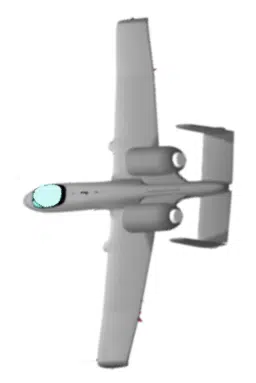
Quick Tips & Solutions
Familiarize yourself with artificial horizon and compass readings in advance. Understanding them well is key to making fast, accurate decisions.
Understand the Artificial Horizon
- The lighter area represents the sky; the darker area represents the earth.
- A “carrot” or arrow typically points “up” (sky) on the gauge. If the center of the airplane symbol is above the horizon line, you’re climbing. If below, you’re descending.
Check Bank Angle
- If the arrow (or carrot) tilts left, the aircraft is banking right, and vice versa. A level arrow means no bank—straight flight.
Compass Heading
- The compass dial shows your heading in degrees relative to north. If the dial reads “090,” the aircraft is heading east, and so on.
Time Management
- Speed is crucial. Answer each question by quickly matching the pitch (up or down) and roll (left or right) with the compass heading. Don’t linger—trust your instruments and move on.
Be Consistent
- The subtest uses the same plane and viewpoint for every question, so once you know the rules (e.g., arrow orientation, compass labeling), apply them uniformly to save time.
Practice Makes Perfect
- Familiarize yourself with artificial horizon and compass readings in advance. Understanding them well is key to making fast, accurate decisions.
Question 11 of 12 – Block Counting
Determine how many blocks the numbered block touches.
Blocks only touch if their faces connect—corner touches don’t count.
All blocks are the same size and shape.
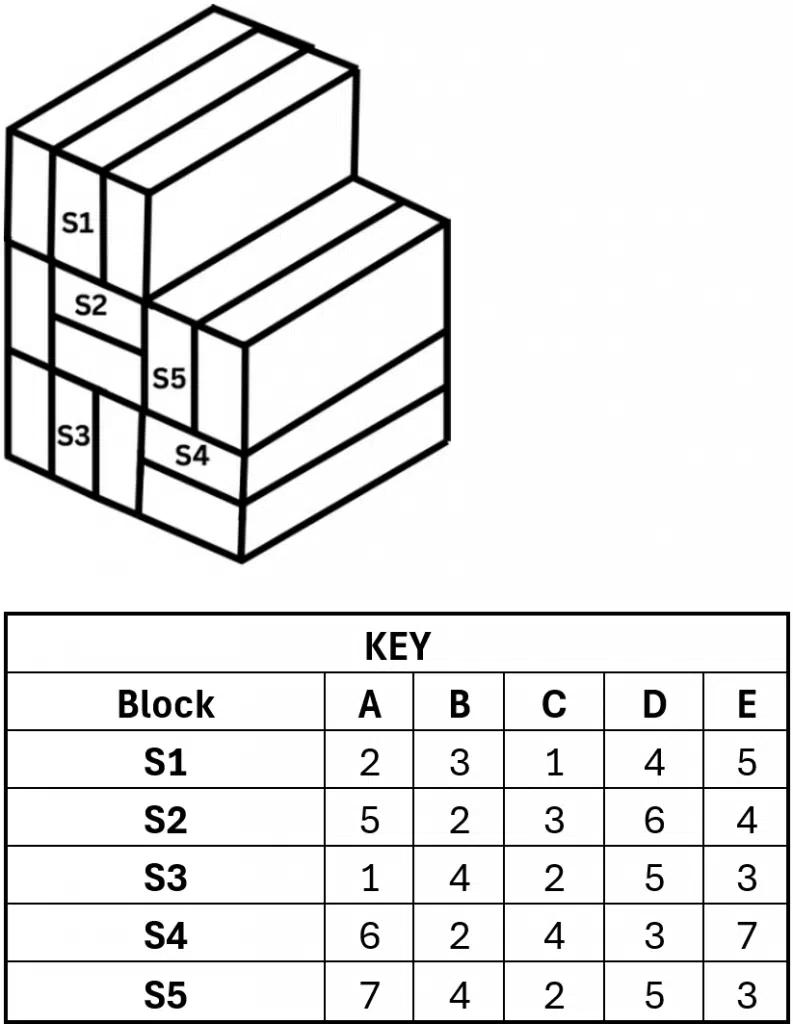
The correct answers are:
- S1 – B (3)
- S2 – A (5)
- S3 – E (3)
- S4 – C (4)
- S5 – B (4)
Explanation:
In this block-counting question, you must determine how many blocks come into contact with a specific block labeled S. By systematically checking each side—top, left, right, and bottom—you avoid double-counting or missing hidden blocks.
- S1 touches 3 blocks.
- None above, one on each side, one below.
- S2 touches 5 blocks.
- Two above (including S1), one on each side, one below.
- S3 touches 3 blocks.
- One above, one on each side, none below.
- S4 touches 4 blocks.
- Two above, one on the left, one below.
- S5 touches 4 blocks.
- None above, two on the left, one on the right, one below.
Tips for a Quick Solution:
Guessing Strategy: In multiple-choice settings, the correct answer often isn’t the extreme high or low. If rushed, pick a middle number to increase your chances.
Divide and Conquer: Focus on one block at a time, listing what’s above, below, and on each side.
Watch for Hidden Blocks: Sometimes blocks are partially obscured or underneath others.
Track Carefully: If allowed, mark blocks off as you count; this helps avoid double-counting.
Question 12 of 12 – Aviation Information
What is the primary reason for using a jet engine instead of a piston engine in modern commercial aircraft?
- Jet engines are more fuel-efficient at lower altitudes
- Jet engines are quieter
- Jet engines produce more thrust
- Jet engines are easier to maintain
- Jet engines operate better in colder weather
The correct answer is C. Jet engines produce more thrust.
Explanation:
Jet engines produce more thrust than piston engines, enabling modern commercial aircraft to handle heavier payloads and achieve higher speeds. This thrust advantage is critical for large passenger jets operating on long routes.
Why Other Options Are Incorrect:
- (A) More Fuel-Efficient at Lower Altitudes: Jet engines are most efficient at higher altitudes, not lower ones.
- (B) Quieter: Jets generally produce significant noise; they’re not chosen for their quiet operation.
- (D) Easier to Maintain: Maintenance can be more involved and expensive for jet engines compared to piston engines.
- (E) Better in Colder Weather: Cold weather tolerance is not the main advantage; thrust output for large airliners is.
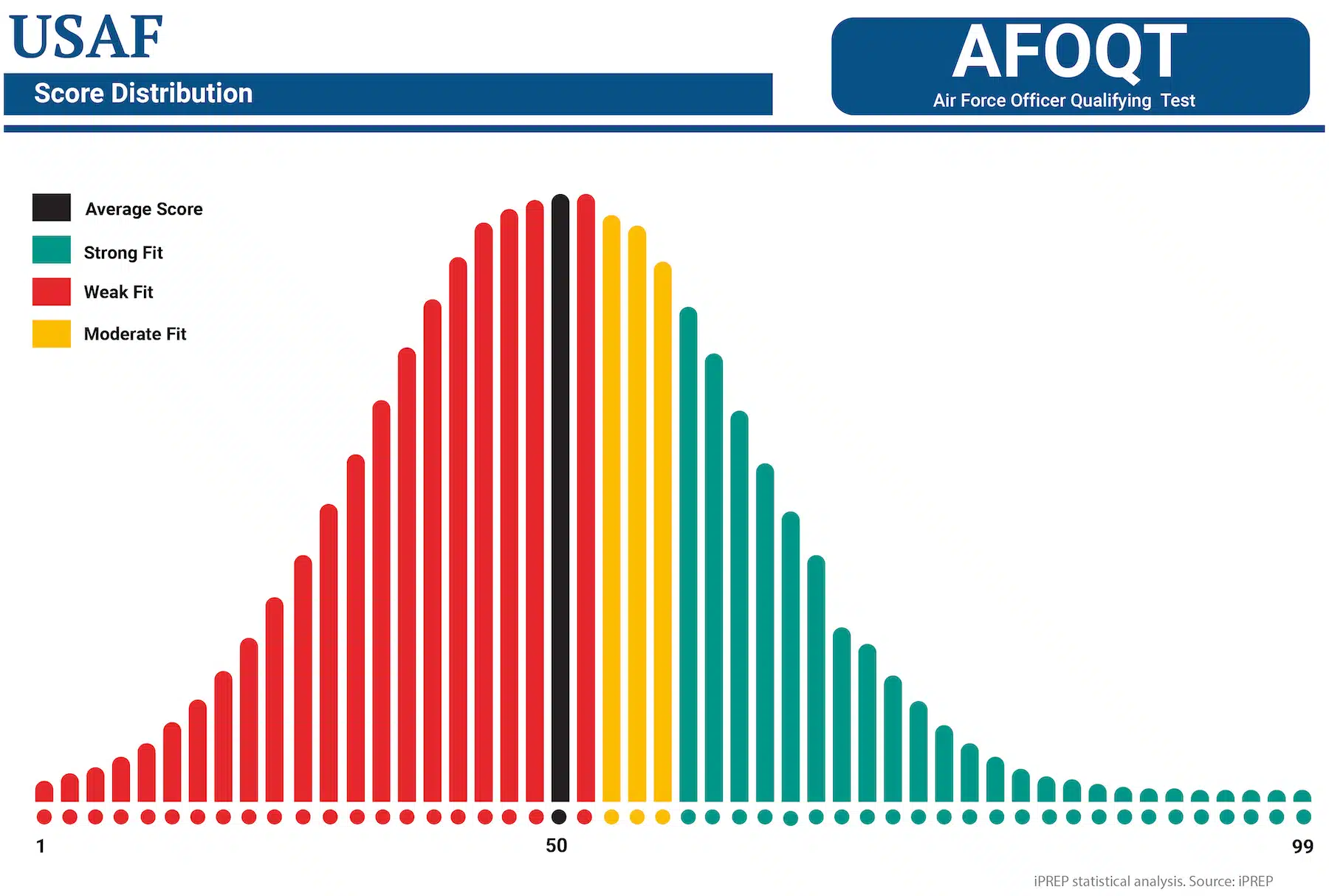
Well done!
You have completed the Sample Questions section.
The complete iPREP course includes full test simulations with detailed explanations and study guides.
‘…TESTS THAT ACTUALLY HELP’

In the first 30 minutes of use I have learned so much more than skipping along the internet looking for free content. Don’t waste you time, pay and get tests that actually help.
Richard Rodgers
January 28, 2020 at 7:49 PM
